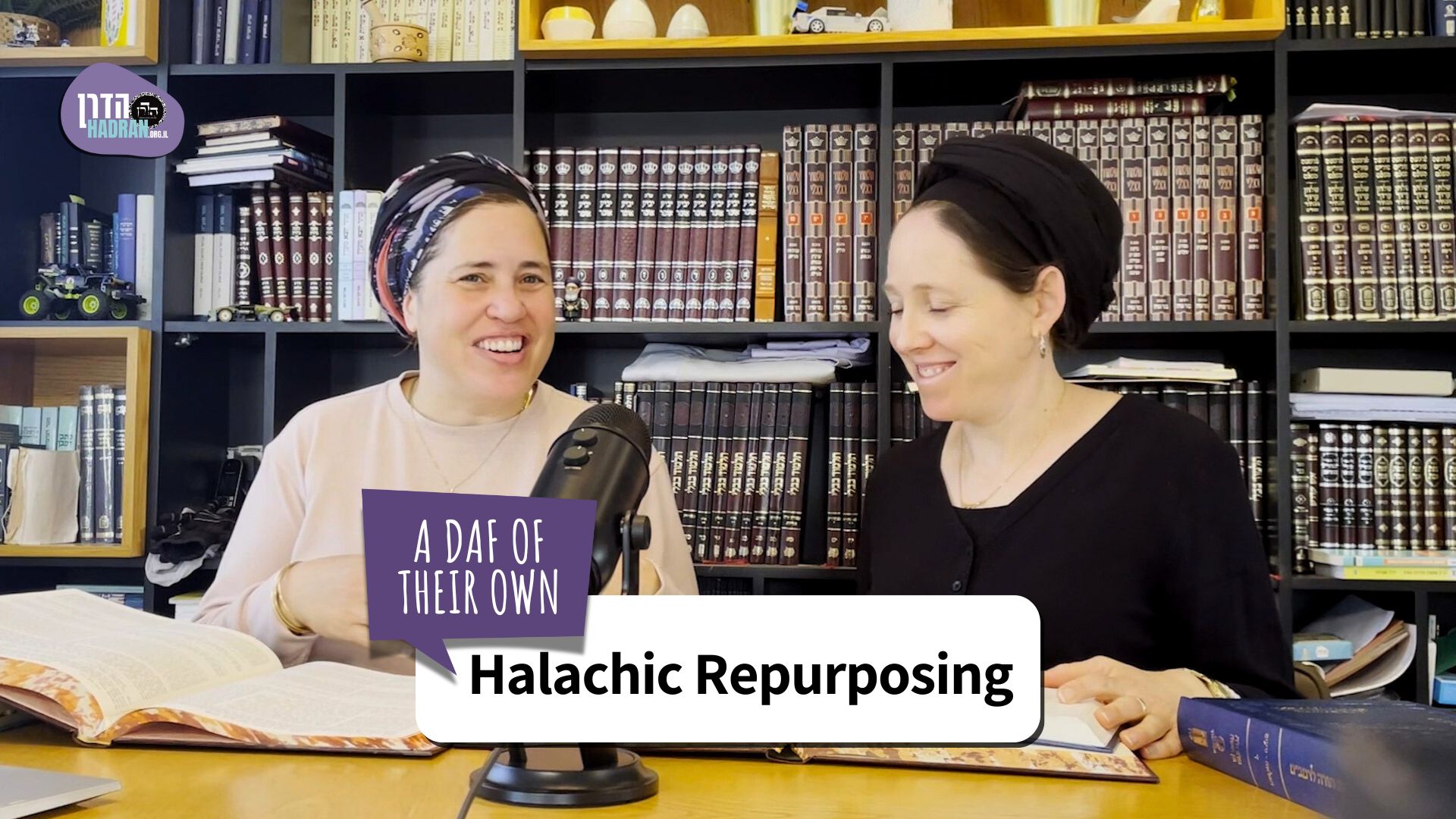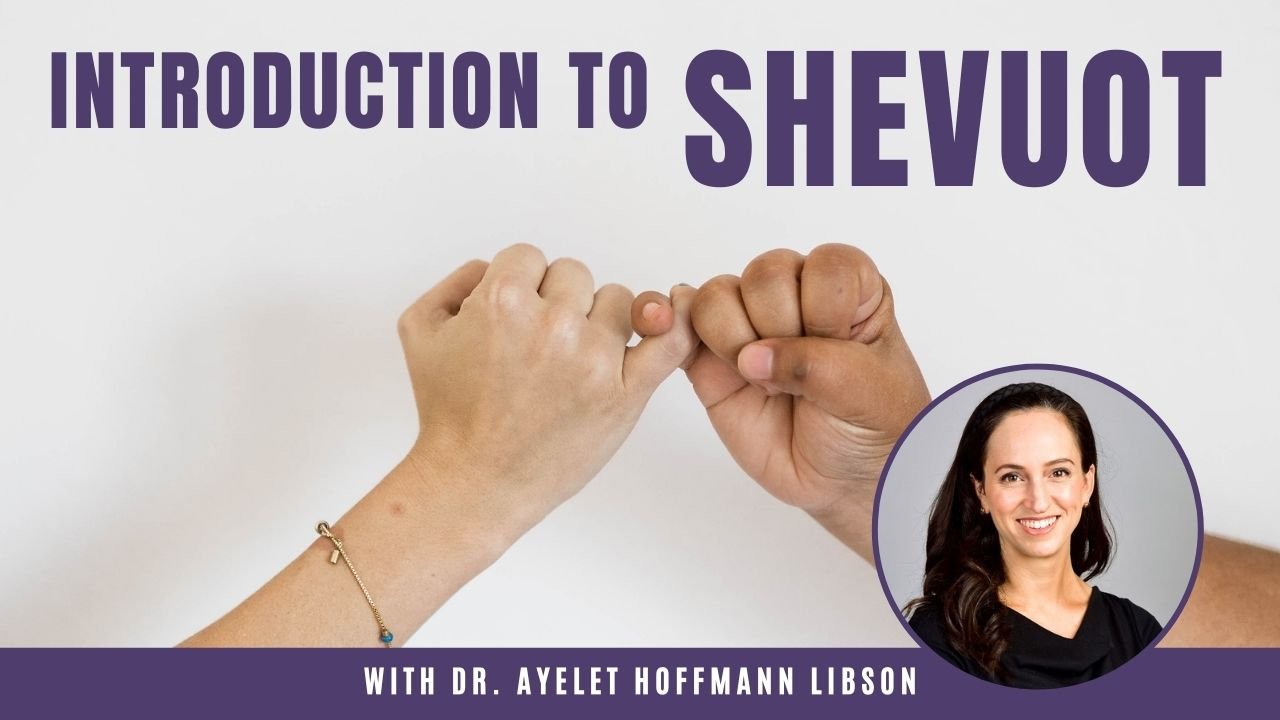Shevuot 10
וְאִיתַּקּוּשׁ שְׂעִירֵי הָרְגָלִים לִשְׂעִירֵי רָאשֵׁי חֳדָשִׁים; מָה שָׂעִיר דְּרֹאשׁ חוֹדֶשׁ בְּמִילְּתָא דְּקוֹדֶשׁ מְכַפְּרִי, אַף שְׂעִירֵי רְגָלִים בְּמִילְּתָא דְּקוֹדֶשׁ מְכַפְּרִי.
And through this additional “and,” the goats of the Festivals are juxtaposed with the goats of the New Moons, indicating that just as the goats of the New Moons atone for a case involving sacrificial food, i.e., where a ritually pure person partook of ritually impure sacrificial food, so too, the goats of the Festivals atone for a similar case involving sacrificial food, i.e., where a ritually impure person partook of ritually pure sacrificial food.
וְכִי תֵּימָא נִיכַפְּרוּ אַדְּרֹאשׁ חֹדֶשׁ – הָא אָמְרִינַן: ״אוֹתָהּ״ – אוֹתָהּ נוֹשֵׂא עָוֹן, וְאֵין אַחֵר נוֹשֵׂא עָוֹן.
And if you would say: Let the goats of the Festivals atone for that which the goats of the New Moon are sacrificed, that is not possible. Didn’t we say above that the verse states with regard to the goat of the New Moon: “And He gave it to you to bear the sin of the congregation,” which indicates that it bears, i.e., atones for, that sin but another does not bear that sin?
וְכִי תֵּימָא נִיכַפְּרוּ אַדְּיוֹם הַכִּפּוּרִים – הָא אָמְרִינַן: ״אַחַת בַּשָּׁנָה״ – כַּפָּרָה זוֹ לֹא תְּהֵא אֶלָּא אַחַת בַּשָּׁנָה.
And if you would say: Let the goats of the Festivals atone for that which the goat of Yom Kippur is brought, that is not possible. Didn’t we say above that the verse states with regard to the goat of Yom Kippur: “Aaron shall bring atonement upon its corners once a year” (Exodus 30:10)? The emphasis on “once a year” teaches that this atonement for this case should be only once a year.
אַמַּאי מְכַפְּרִי?
The Gemara explains: It must be that the goats of the Festivals atone for cases of defiling of the Temple or its sacrificial foods in which one did not have awareness, neither at the beginning nor at the end, because if not, for what other matter involving sacrificial foods could they atone?
אִי עַל שֶׁיֵּשׁ בָּהּ יְדִיעָה בַּתְּחִלָּה וְיֵשׁ בָּהּ יְדִיעָה בַּסּוֹף – הַאי בַּר קׇרְבָּן הוּא! אִי עַל שֶׁיֵּשׁ בָּהּ יְדִיעָה בַּתְּחִלָּה וְאֵין בָּהּ יְדִיעָה בַּסּוֹף – הַאי שָׂעִיר הַנַּעֲשֶׂה בִּפְנִים וְיוֹם הַכִּפּוּרִים תּוֹלֶה! אִי עַל שֶׁאֵין בָּהּ יְדִיעָה בַּתְּחִלָּה אֲבָל יֵשׁ בָּהּ יְדִיעָה בַּסּוֹף – הַאי שָׂעִיר הַנַּעֲשֶׂה בַּחוּץ וְיוֹם הַכִּפּוּרִים מְכַפֵּר!
If you say they atone for cases in which one had awareness at the beginning and had awareness at the end, then one can counter that he is liable to bring an offering to atone for his transgression, and therefore the goats of the Festivals will not atone for him. If you say they atone for cases in which one had awareness at the beginning but did not have awareness at the end, then one can counter that the goat whose blood presentation is performed inside the Sanctuary and Yom Kippur itself suspend any punishment that he deserves until he becomes aware of his transgression. If you say they atone for cases in which one did not have awareness at the beginning but did have awareness at the end, then one can counter that the goat whose blood presentation is performed outside the Sanctuary and Yom Kippur itself atone.
עַל כׇּרְחָךְ, אֵינוֹ מְכַפֵּר אֶלָּא עַל שֶׁאֵין בָּהּ יְדִיעָה לֹא בַּתְּחִלָּה וְלֹא בַּסּוֹף.
Perforce, they atone only for cases in which one did not have awareness, neither at the beginning nor at the end.
רַבִּי מֵאִיר אוֹמֵר: כׇּל הַשְּׂעִירִים כַּפָּרָתָן שָׁוָה כּוּ׳.
§ The mishna teaches that Rabbi Meir says: The atonement effected by all the goats offered as part of the additional offerings, i.e., those of the New Moons, Festivals, and Yom Kippur, is the same. They all atone for various cases of the defiling of the Temple or its sacrificial foods.
אָמַר רַבִּי חָמָא בַּר רַבִּי חֲנִינָא: מַאי טַעְמָא דְּרַבִּי מֵאִיר? אָמַר קְרָא ״שְׂעִיר״–״וּשְׂעִיר״, הוּקְּשׁוּ כׇּל הַשְּׂעִירִים זֶה לָזֶה – וָי״ו מוֹסִיף עַל עִנְיָן רִאשׁוֹן.
Rabbi Ḥama bar Rabbi Ḥanina said: What is the reasoning of Rabbi Meir? With regard to the goat of the Festivals (Numbers, chapters 28–29) the verse could have simply stated: A goat, but instead it states: “And a goat,” which teaches that all the goats are juxtaposed, this one with that one, as the use of the term “and” teaches that the second matter adds to the first matter, and that all the goats effect a similar atonement as the first one listed, that of the New Moon.
קָסָלְקָא דַּעְתָּךְ כֹּל חַד וְחַד מֵחַבְרֵיהּ גָּמַר?! וְהָאָמַר רַבִּי יוֹחָנָן: כׇּל הַתּוֹרָה כּוּלָּהּ לְמֵידִין לָמֵד מִלָּמֵד, חוּץ מִקֳּדָשִׁים שֶׁאֵין לְמֵידִין לָמֵד מִלָּמֵד!
The Gemara questions this interpretation: Initially it enters your mind to explain that the atonement effected by each and every one of the goats of the Festivals is derived from the atonement effected by the goat adjacent to it, i.e., the one mentioned in the passage immediately preceding it: The atonement effected by the Passover goat from the atonement effected by the goat of the New Moon and the atonement effected by the Shavuot goat from the atonement effected by the Passover goat and so forth. But this is difficult, as doesn’t Rabbi Yoḥanan say: With regard to the entire Torah, one derives a halakha derived via a juxtaposition from a halakha derived via a juxtaposition, except for halakhot concerning consecrated matters, where one does not derive a halakha derived via a juxtaposition from a halakha derived via a juxtaposition?
הָא לָא קַשְׁיָא, כּוּלְּהוּ מִקַּמָּא גָּמְרִי.
The Gemara answers: This is not difficult, because actually the atonement effected by all of the goats is derived directly from the atonement effected by the first goat, i.e., the goat of the New Moon.
תִּינַח כֹּל דִּכְתִב בֵּיהּ ״וּשְׂעִיר״, עֲצֶרֶת וְיוֹם הַכִּפּוּרִים דְּלָא כְּתִב בֵּיהּ ״וּשְׂעִיר״ – מְנָלַן?
The Gemara asks: Rabbi Ḥama bar Rabbi Ḥanina’s explanation works out well for all the goats with regard to which it is written: “And a goat,” but from where do we derive what the goats of Shavuot and Yom Kippur atone for, as with regard to them it is not written: And a goat, but simply: “A goat”?
אֶלָּא אָמַר רַבִּי יוֹנָה, אָמַר קְרָא: ״אֵלֶּה תַּעֲשׂוּ לַה׳ בְּמוֹעֲדֵיכֶם״ – הוּקְּשׁוּ כׇּל הַמּוֹעֲדִים כּוּלָּן זֶה לָזֶה. וְהָא רֹאשׁ חֹדֶשׁ לָאו מוֹעֵד הוּא!
Rather, Rabbi Yona says: The verse states at the end of the passage detailing the goats of the Festivals: “These shall you offer to the Lord on your Festivals” (Numbers 29:39); with this verse all the goats of the Festivals are juxtaposed, this one with that one, which indicates that they all atone for the same sins. The Gemara challenges: But the New Moon is not regarded as a Festival.
אִיבְרָא, רֹאשׁ חֹדֶשׁ נָמֵי אִיקְּרִי מוֹעֵד, כִּדְאָמַר אַבָּיֵי – דְּאָמַר אַבָּיֵי: תַּמּוּז דְּהַהִיא שַׁתָּא מַלּוֹיֵי מַלְּיוּהּוֹ, דִּכְתִיב: ״קָרָא עָלַי מוֹעֵד לִשְׁבֹּר בַּחוּרָי״.
The Gemara refutes this: In truth, the New Moon is also called a Festival, in accordance with what Abaye says with regard to a different issue, as Abaye says: With regard to the month of Tammuz in that year during which the Jewish people sinned by accepting the slanderous report of the spies about Eretz Yisrael, the court made it a full month of thirty days, as it is written: “He proclaimed a festival to crush my young men” (Lamentations 1:15). Abaye understands the verse to mean that by extending the month of Tammuz by an extra day, by proclaiming that the thirtieth day should be celebrated as a New Moon in addition to the first day of the following month, it emerged that the acceptance of the spies’ report occurred on the ninth of Av, and not the eighth, thereby defining the ninth of Av as an ominous day for the Jewish people. From Abaye’s explanation it is apparent that the New Moon is also called a Festival.
אָמַר רַבִּי יוֹחָנָן: וּמוֹדֶה רַבִּי מֵאִיר בְּשָׂעִיר הַנַּעֲשֶׂה בִּפְנִים, שֶׁהוּא אֵינוֹ מְכַפֵּר כַּפָּרָתָן, וְהֵן אֵינָן מְכַפְּרִין כַּפָּרָתוֹ.
The Gemara continues to analyze Rabbi Meir’s opinion: Rabbi Yoḥanan says: And even though he holds that all the goats offered as part of the additional offerings effect atonement for the same sin, Rabbi Meir concedes with regard to the goat whose blood presentation is performed inside the Sanctuary on Yom Kippur that it does not atone their atonement, i.e., does not atone for the sins that they atone for, and they do not atone its atonement.
הוּא אֵינוֹ מְכַפֵּר כַּפָּרָתָן – כַּפָּרָה אַחַת מְכַפֵּר, וְאֵינוֹ מְכַפֵּר שְׁתֵּי כַּפָּרוֹת. הֵן אֵינָן מְכַפְּרִין כַּפָּרָתוֹ – אָמַר קְרָא ״אַחַת בַּשָּׁנָה״, כַּפָּרָה זוֹ לֹא תְּהֵא אֶלָּא אַחַת בַּשָּׁנָה.
He elaborates: It does not atone their atonement, because, as the Gemara derived from the verse: “Aaron shall bring atonement upon its corners once a year” (Exodus 30:10), the internal goat effects one atonement for only one case but cannot effect two atonements for two different cases. And they do not atone its atonement, because, as the Gemara explained, the verse states: “Aaron shall bring atonement upon its corners once a year.” The emphasis on the phrase “once a year” teaches that this atonement for the specific case that it atones for should be only once a year.
תַּנְיָא נָמֵי הָכִי: עַל שֶׁאֵין בָּהּ יְדִיעָה לֹא בַּתְּחִלָּה וְלֹא בַּסּוֹף, וְעַל שֶׁאֵין בָּהּ יְדִיעָה בַּתְּחִלָּה אֲבָל יֵשׁ בָּהּ יְדִיעָה בַּסּוֹף, וְעַל טָהוֹר שֶׁאָכַל אֶת הַטָּמֵא – שְׂעִירֵי הָרְגָלִים וּשְׂעִירֵי רָאשֵׁי חֳדָשִׁים וְשָׂעִיר הַנַּעֲשֶׂה בַּחוּץ מְכַפְּרִין. דִּבְרֵי רַבִּי מֵאִיר.
The Gemara adds: This qualification of Rabbi Meir’s opinion is also indicated by that which is taught in a baraita: For cases of the defiling of the Temple in which one did not have awareness, neither at the beginning nor at the end, and for cases in which one did not have awareness at the beginning but did have awareness at the end, and for a ritually pure person who partook of ritually impure sacrificial food, the goats of the Festivals and the goats of the New Moons and the goat whose blood presentation is performed outside the Sanctuary atone. This is the statement of Rabbi Meir.
וְאִילּוּ שָׂעִיר הַנַּעֲשֶׂה בִּפְנִים שַׁיְּירֵהּ, (וכפרתן) [וְכַפָּרָתוֹ] נָמֵי שַׁיְּירַהּ.
The Gemara notes: But in delineating which offerings atone, Rabbi Meir omitted the goat whose blood presentation is performed inside the Sanctuary, and furthermore, when delineating their atonement, i.e., what cases they atone for, he also omitted it, i.e., he did not mention the cases that the internal goat atones for, which are the cases in which one had awareness at the beginning but did not have awareness at the end. Evidently, the atonement of the internal goat is substantively different from the atonement of the other goats.
הָיָה רַבִּי שִׁמְעוֹן אוֹמֵר: שְׂעִירֵי רָאשֵׁי חֳדָשִׁים מְכַפְּרִין עַל טָהוֹר שֶׁאָכַל אֶת הַטָּמֵא כּוּ׳.
§ The mishna teaches: Rabbi Shimon would say: The goats of the New Moons atone for a ritually pure person who unwittingly partook of ritually impure sacrificial food. And for defiling the Temple or its sacrificial foods, the goats of the Festivals atone for cases in which one did not have awareness, neither at the beginning nor at the end, and the goats of the additional offerings of Yom Kippur atone for cases in which one did not have awareness at the beginning but did have awareness at the end.
בִּשְׁלָמָא דְּרָאשֵׁי חֳדָשִׁים לָא מְכַפְּרִי אַדִּרְגָלִים, דְּאָמַר קְרָא: ״עֲוֹן״ – עָוֹן אֶחָד הוּא נוֹשֵׂא, וְאֵינוֹ נוֹשֵׂא שְׁנֵי עֲוֹנוֹת. אֶלָּא דִּרְגָלִים נִיכַפְּרוּ אַדְּרָאשֵׁי חֳדָשִׁים! אָמַר קְרָא: ״אוֹתָהּ״ – אוֹתָהּ נוֹשֵׂא עָוֹן, וְאֵין אַחֵר נוֹשֵׂא עָוֹן.
The Gemara challenges: Granted, the goats of the New Moons do not atone for that which the goats of Festivals atone, as the verse states with regard to the goat of the New Moon: “And he gave it to you to bear the sin of the congregation” (Leviticus 10:17), which indicates that it bears, i.e., atones for, one sin but does not bear two sins. But nevertheless, let the goats of the Festivals atone for that which the goats of New Moons atone. The Gemara responds: The verse states: “He gave it to you.” The emphasis on “it” teaches that it bears this sin, but no other offering bears this sin.
בִּשְׁלָמָא דִּרְגָלִים לָא מְכַפְּרִין אַדְּיוֹם הַכִּפּוּרִים, דְּאָמַר קְרָא ״אַחַת בַּשָּׁנָה״ – כַּפָּרָה זוֹ לֹא תְּהֵא אֶלָּא אַחַת בַּשָּׁנָה. אֶלָּא דְּיוֹם הַכִּפּוּרִים נִיכַפְּרוּ אַדִּרְגָלִים! אָמַר קְרָא ״אַחַת״ – כַּפָּרָה אַחַת מְכַפֵּר, וְאֵינוֹ מְכַפֵּר שְׁתֵּי כַּפָּרוֹת.
The Gemara challenges: Granted, the goats of the Festivals do not atone for that which the goats of Yom Kippur atone, as the verse states with regard to the goat of Yom Kippur: “Aaron shall bring atonement upon its corners once a year” (Exodus 30:10). The emphasis on the phrase “once a year” teaches that this atonement, i.e., the specific case it atones for, should be only once a year. But nevertheless, let the goats of Yom Kippur atone for that which the goats of the Festivals atone. The Gemara responds: The verse states: “Once a year,” which indicates that it effects one atonement for only one case but cannot effect two atonements for two different cases.
וְהָא כִּי כְּתִיב ״אַחַת״ – בְּשָׂעִיר הַנַּעֲשֶׂה בִּפְנִים הוּא דִּכְתִיב! אָמַר קְרָא: ״מִלְּבַד
The Gemara challenges the use of these derivations: But when it states “once” in this verse, it is with regard to the goat whose blood presentation is performed inside the Sanctuary that it is written, so the derivations from it should have no bearing on the discussion concerning the external goat. The Gemara answers: The verse states: “One goat for a sin-offering aside from
חַטַּאת הַכִּפּוּרִים״, וְאִיתַּקּוּשׁ חִיצוֹן לִפְנִימִי.
the sin-offering of the atonements” (Numbers 29:11). “One goat for a sin-offering” is referring to the external goat, and “the sin-offering of the atonements” is referring to the internal goat. With this verse, the external goat is juxtaposed with the internal goat, and therefore the limitations imposed on the atonement of the internal goat are also to be applied to the external goat.
רַבִּי שִׁמְעוֹן בֶּן יְהוּדָה אוֹמֵר מִשְּׁמוֹ כּוּ׳.
§ The mishna teaches: Rabbi Shimon ben Yehuda says in the name of Rabbi Shimon a version of his opinion that differs from that of the mishna above: The goats of the New Moons atone for a ritually pure person who unwittingly partook of ritually impure sacrificial food. The goats of the Festivals exceed them, as they atone both for a ritually pure person who partook of ritually impure sacrificial food and also atone for cases of defiling the Temple or its sacrificial foods where one did not have awareness, neither at the beginning nor at the end. The goats of Yom Kippur further exceed them, as they atone both for a ritually pure person who partook of ritually impure sacrificial food and for cases of defiling the Temple or its sacrificial foods in which one did not have awareness, neither at the beginning nor at the end; and they also atone for cases in which one did not have awareness at the beginning but did have awareness at the end.
מַאי שְׁנָא דְּרָאשֵׁי חֳדָשִׁים דְּלָא מְכַפְּרִי אַדִּרְגָלִים – דְּאָמַר קְרָא ״עֲוֹן״, עָוֹן אֶחָד הוּא נוֹשֵׂא וְאֵינוֹ נוֹשֵׂא שְׁנֵי עֲוֹנוֹת; דִּרְגָלִים נָמֵי לָא נִיכַפְּרוּ אַדְּרָאשֵׁי חֳדָשִׁים – דְּאָמַר קְרָא ״אוֹתָהּ״, אוֹתָהּ הוּא נוֹשֵׂא עָוֹן וְאֵין אַחֵר נוֹשֵׂא עָוֹן! ״אוֹתָהּ״ לֹא מַשְׁמַע לֵיהּ.
The Gemara asks: What is different about the goats of the New Moons that they do not atone for that which the goats of the Festivals atone? The Gemara answers: As the verse states with regard to any one of the goats of the New Moons: “And He gave it to you to bear the sin of the congregation” (Leviticus 10:17), which teaches that it bears, i.e., atones for, one sin but does not bear two sins. The Gemara asks: If so, the goats of the Festivals should also not atone for that which the goats of the New Moons atone, as that same verse states: “And He gave it to you,” which indicates that it bears, i.e., atones for, that sin, but nothing else bears that sin. Why then does Rabbi Shimon ben Yehuda cite Rabbi Shimon as holding that the goats of the Festivals do atone for that which the goats of the New Moons atone? The Gemara answers: Rabbi Shimon does not learn anything from the word “it.” Accordingly, he holds that any one of the goats of the Festivals can atone for two different sins.
מַאי שְׁנָא דִּרְגָלִים דְּלָא מְכַפְּרִי אַדְּיוֹם הַכִּפּוּרִים – דְּאָמַר קְרָא ״אַחַת בַּשָּׁנָה״, כַּפָּרָה זוֹ לֹא תְּהֵא אֶלָּא אַחַת בַּשָּׁנָה; אִי הָכִי, דְּיוֹם הַכִּפּוּרִים נָמֵי לָא נִיכַפְּרוּ אַדִּרְגָלִים – ״אַחַת״ כְּתִיב, כַּפָּרָה אַחַת מְכַפֵּר וְאֵינוֹ מְכַפֵּר שְׁתֵּי כַּפָּרוֹת! ״אַחַת״ לָא מַשְׁמַע לֵיהּ.
The Gemara asks further: What is different about the goats of the Festivals that they do not atone for that which the goats of Yom Kippur atone? As the verse states with regard to the goat of Yom Kippur: “Once a year” (Exodus 30:10), which teaches that this atonement for the specific case that it atones for should be only once a year, and therefore no other offering can atone for it. The Gemara challenges: If so, the goats of Yom Kippur should also not atone for that which the goats of the Festivals atone, as it is written: “Once a year,” which teaches that the goats effect one atonement for only one case but cannot effect two atonements for two cases. Why then does Rabbi Shimon ben Yehuda cite Rabbi Shimon as holding that the goats of Yom Kippur atone for everything that the goats of the Festivals atone for? The Gemara answers: Rabbi Shimon does not learn anything from the word “once.” Accordingly, he holds that the goats of Yom Kippur can atone for three different cases.
אַמַּאי? דְּכִי כְּתִיב ״אַחַת״ – בְּשָׂעִיר הַנַּעֲשֶׂה בִּפְנִים כְּתִיב. אִי הָכִי, דִּרְגָלִים נָמֵי נְכַפְּרוּ אַדְּיוֹם הַכִּפּוּרִים, דְּכִי כְּתִיב ״אַחַת״ – בְּשָׂעִיר הַנַּעֲשֶׂה בִּפְנִים כְּתִיב!
The Gemara asks: Why doesn’t he expound the word “once”? He does not expound it because when the word “once” is written, it is written with regard to the goat whose blood presentation is performed inside the Sanctuary, and so the halakha derived from that verse has no bearing on the capacity of the goat whose blood presentation is performed outside the Sanctuary to atone. The Gemara asks: If so, the goats of the Festivals also should atone for that which the goats of Yom Kippur atone, as when the phrase “once a year” is written, it is written with regard to the goat whose blood presentation is performed inside the Sanctuary, so the halakha derived from that verse has no bearing on whether another offering can atone for that which the external goat atones.
לְעוֹלָם ״אַחַת״ מַשְׁמַע לֵיהּ; וְשָׁאנֵי הָכָא, דְּאָמַר קְרָא: ״וְכִפֶּר אַהֲרֹן עַל קַרְנֹתָיו אַחַת בַּשָּׁנָה״ – קַרְנוֹתָיו דְּמִזְבֵּחַ הַפְּנִימִי הוּא דְּכַפָּרָה אַחַת מְכַפֵּר וְאֵינוֹ מְכַפֵּר שְׁתֵּי כַּפָּרוֹת, הָא דְּחִיצוֹן אֲפִילּוּ שְׁתֵּי כַּפָּרוֹת.
The Gemara answers: Actually, he does learn a halakha from the word “once,” and he holds that it also teaches about the capacity of the external goat to atone, as the Gemara explained above. But it is different here, with regard to the derivation that the goat cannot effect two atonements, as the verse states: “And Aaron shall bring atonement upon its corners once a year” (Exodus 30:10). The emphasis on “upon its corners” teaches that it is only with regard to the internal goat, whose blood presentation is performed upon the corners of the internal altar, that it effects one atonement for only one case but cannot effect two atonements for two different cases, but the external goat, whose blood presentation is performed upon the corners of the external altar, can effect even two different atonements.
אָמַר עוּלָּא אָמַר רַבִּי יוֹחָנָן: תְּמִידִין שֶׁלֹּא הוּצְרְכוּ לַצִּבּוּר, נִפְדִּין תְּמִימִים.
§ Animals purchased with funds collected for public offerings may be sacrificed only during the fiscal year in which those funds were given. For this purpose, the fiscal year begins on the first of Nisan. Generally, once an animal has been consecrated as an offering, then even if for some reason it may no longer be sacrificed, it still cannot be redeemed unless it develops a blemish. Rabbi Yoḥanan teaches an exception to this halakha: Ulla says that Rabbi Yoḥanan says: Lambs consecrated for the daily offerings that were not needed by the public during the fiscal year in which they were purchased are redeemed, even if they are unblemished, and they may then be used for non-sacred purposes.
יָתֵיב רַבָּה וְקָאָמַר לַהּ לְהָא שְׁמַעְתָּא. אֲמַר לֵיהּ רַב חִסְדָּא: מַאן צָיֵית לָךְ וּלְרַבִּי יוֹחָנָן רַבָּךְ? וְכִי קְדוּשָּׁה שֶׁבָּהֶן לְהֵיכָן הָלְכָה?
Rabba was sitting and reciting this halakha. Rav Ḥisda said to him: Who will listen to you and Rabbi Yoḥanan, your teacher, with regard to this halakha? Rav Ḥisda clarified: But the sanctity that was inherent in them, to where has it gone? Since these animals were consecrated as offerings, they should have been endowed with inherent sanctity. Only sanctity that inheres in an item’s value, i.e., an item consecrated to the Temple treasury, can be desacralized through redemption, but an item with inherent sanctity can never be desacralized.
אֲמַר לֵיהּ: אַתְּ לָא תִּסְבְּרַהּ דְּלָא אָמְרִינַן ״קְדוּשָּׁה שֶׁבָּהֶן לְהֵיכָן הָלְכָה״?! וְהָתְנַן: מוֹתַר הַקְּטוֹרֶת, מָה הָיוּ עוֹשִׂין בָּהּ? מַפְרִישִׁין מִמֶּנָּה שְׂכַר הָאוּמָּנִין, וּמְחַלְּלִין אוֹתָהּ עַל מְעוֹת הָאוּמָּנִין, וְנוֹתְנִין אוֹתָהּ לָאוּמָּנִין בִּשְׂכָרָן, וְחוֹזְרִין וְלוֹקְחִין אוֹתָהּ מִתְּרוּמָה חֲדָשָׁה.
Rabba said to him: Don’t you also hold that we do not say that the question: The sanctity that was inherent in them, to where has it gone, poses a difficulty? But didn’t we learn in a mishna (Shekalim 4:5): In any fiscal year, one may use only incense that was purchased with funds collected for that year. Accordingly, the mishna asks: With regard to the surplus incense that remained unused at the end of the fiscal year, what would the Temple treasurers do with it in order to render it usable for the following year? They would separate from the Temple treasury the wages for the artisans who worked for the Temple, and those funds would thereby be desacralized. And then they would desacralize the surplus incense by transferring its sanctity to that money that had been set aside for the artisans. Then, they would give the now-desacralized incense to the artisans as their wages, and finally, they would repurchase it with funds from the new collection carried out for the coming year.
וְאַמַּאי? נֵימָא: ״קְדוּשָּׁה שֶׁבָּהֶן לְהֵיכָן הָלְכָה״!
Rabba explains the proof from the mishna: One could ask: But why should the method described work? Let us say: The sanctity that was inherent in the incense, to where has it gone? It cannot be removed by redeeming it. Perforce, even you must concede that this question does not pose a difficulty.
אֲמַר לֵיהּ: קְטוֹרֶת קָאָמְרַתְּ? שָׁאנֵי קְטוֹרֶת,
Rav Ḥisda said to him: Did you say that there is a proof from the halakhot of incense? One cannot compare incense to animals consecrated for the daily offerings, since incense is different,

























